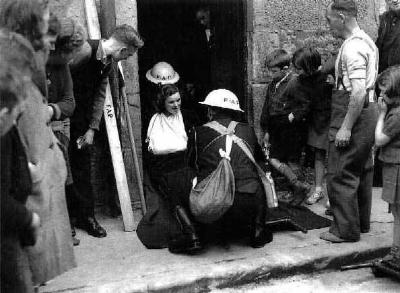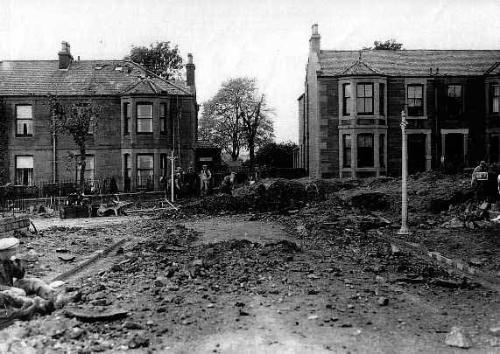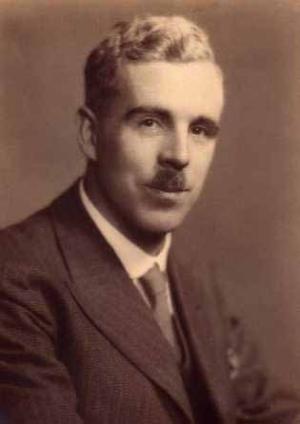Emergency Procedures
As early as January 1938 a meeting was held in Perth council chambers to discuss preparations for war. First aid posts were set up around the town, as they would be throughout Tayside. The local centre of the St Andrew's Ambulance Association took on the responsibility for organising and promoting first aid throughout Perthshire.

Demonstration of a home-made ambulance trailer at Perth City Hall, 1939
(Courtesy of D C Thomson)
Specially adapted hospital trains arrived at Perth station bringing large numbers of wounded servicemen who were then transferred to fleets of ambulance wagons and taken to Bridge of Earn Hospital for treatment. One former ambulance driver later remembered: "Once you had your four patients you had to follow the very faint light of the ambulance in front - a slow process as your lights were only slits cut across normal lights painted black. At Bridge of Earn Hospital we delivered the wounded and went to another ward for blankets for our next contingent. The lovely cups of tea given by WVS mobile canteens at the station were very welcome."
In Dundee, the Royal Infirmary had wards set aside for treating British casualties and German prisoners of war. For much of the war they remained unused (while other hospitals were overcrowded), but after D-Day in 1944 several casualties arrived, including John Wetjen of the Royal Marines. He later recalled: "I couldn't have been further from home. Nor could I have received better treatment and care from the medical staff, not forgetting the kindness of the local people who visited us bringing gifts. Once a week an Officer and a senior NCO would visit the military wards. The NCO would march inside the door then bellow, 'Military patients, lay at attention.' The officer would then enter, look round and then disappear. The Sergeant then roared, 'Lay at ease!'"

A first-aid exercise in Lochee, 1942 (Courtesy of D C Thomson)
For the civilian population there was the ever-present fear of gas attacks, though in fact these never happened in Britain. Maryfield Hospital in Dundee had six treatment stations specially set aside for gas attack victims. Air raid warnings were also mercifully infrequent. On one occasion Dundee's chief of police despaired at the casual attitude of summer holidaymakers at Broughty Ferry, who continued their sunbathing despite an air raid warning! In fact there were no shelters nearby even if they had paid attention to the sirens. The Corporation's Wartime Emergency Committee received at least one deputation from Dundee citizens asking for better protection from air raids and requesting that the Law Tunnel, a relic of the old Newtyle Railway, be re-opened as a bomb shelter.
The first bombs to fall in Tayside came in June 1940 when the Moncrieff railway tunnel in Perth was attacked by one of a squadron of enemy aircraft flying between the Forth and Montrose. The first fatalities came in July when Montrose airfield was bombed, killing two RAF personnel and injuring nine others. Dundee docks were targeted that same month and the city itself was first bombed in August.
The first casualties came on 5th November, when several bombs fell in and around Blackness Road. Three people were killed and seven casualties were taken to the Royal Infirmary, but as former nurse Bunty Smith recalls, "when you went on duty you'd have thought the whole of Dundee was bombed - you never saw such chaos!" Altogether, 41 first aid parties, 26 ambulances, 30 first aid and casualty cars, 26 rescue squads and 6 decontamination squads turned out that night. Although further bombs fell in 1941 there were no more fatalities. Only 3 people died from the bombings in Dundee, compared to nearly 100 in Aberdeen.

Bomb Damage in Dalkeith Road, Dundee (Courtesy of D C Thomson)
Thankfully there was only one direct attack on any of Tayside's hospitals - on 2nd October 1940 when five high-explosive bombs fell on Sunnyside Hospital near Montrose. One missed the main building by only twelve feet, while another hit the kitchen area of North Esk House, injuring two nurses. Despite her injuries, one of them (Nurse Reid) managed to escort her colleague to safety and then reach her ward to calm the patients. For this action she was awarded the George Medal, the first to be given in Scotland.

Dr William Fyffe Dorward (Courtesy of Dr Morrison Dorward)
The war affected all medical staff, including GPs. Every conscript had to be examined by a doctor to see if they were medically fit for service. This was dealt with civilian GPs until the Royal Army Medical Corps had sufficient resources to take over. Visiting patients by car became harder when petrol was rationed. Dr Morrison Doward recalls that his father, a GP in Dundee, "used every downhill stretch of road to switch off the ignition and coast in neutral. The biggest triumph was to freewheel all the way from Birkhill to Lochee, in dry road conditions with a northwest wind."
Read more about Dr Dorward.
Next Page Previous Page